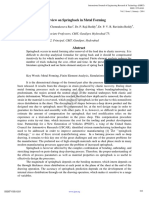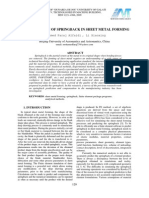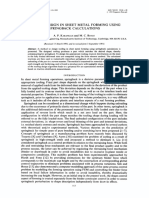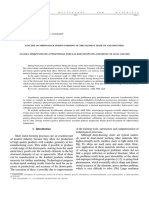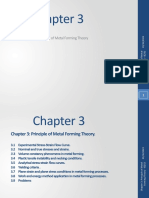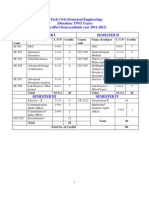Characterising The Effect of Springback On Mechanically Formed Steel Plates
Uploaded by
puneethudupiCharacterising The Effect of Springback On Mechanically Formed Steel Plates
Uploaded by
puneethudupiAbstract In the bending operation, springback causes geometrical
inaccuracies of bent parts. To curb springback, various factors such
as bending parameters and material properties need to be considered.
This paper reports the effects of springback on mechanically formed
steel plates. Experimental work using circular bending was conducted
to analyse the effect of springback on the formed steel sheets. The
sheets were bent using a punch and die having a radius of curvature
of 120 mm. In addition, the formed samples were characterized
through microstructure, microhardness and tensile results. The results
revealed an error due to springback of 4.24%. Furthermore, the
Vickers microhardness of the formed samples compared to the parent
materials shows an increase of 6% while the Ultimate Tensile
Strength also increased by 7%. The effects of strain hardening
resulting from the bending process led to the increased hardness and
strength of the material. The formed samples had elongated grains
when compared to the equiaxed grains of the parent material. The
increase in the grains can be attributed to the stretching of the
material during the bending process.
Keywords Mechanical forming, springback,
I. INTRODUCTION
HEET metal bending plays a very important role in the
manufacturing industry. As the industry develops, the size
of the components being produced gets smaller and tolerances
on them gets tighter. The geometrical accuracy of a bent part
is crucial in determining the quality of the component [1].
Analysis of the process of sheet metal bending reveals a
phenomenon called springback. Springback is the term used to
describe the elastic recovery of sheet metal after a bending
operation [2]. Problems relating to springback do not only
affect formed components, but also affect the design of the
bending tools such as the forming dies. When a sheet
undergoes a bending operation, usually on presses, it is
deformed to a certain degree and takes the shape of the die.
However, as soon as the die is removed, the sheet recovers
slightly towards it original shape. In other words, the sheet
does not maintain the final radius of curvature of the load
condition, but it recovers elastically to a much larger final
Dr E. T. Akinlabi is a Senior Lecturer in the Department of Mechanical
Engineering Science, University of Johannesburg, Auckland Park,
Johannesburg, South Africa, 2006. Phone: +2711-559-2137; e-mail:
etakinlabi@uj.ac.za).
Mr Kagisho Matlou is a graduate candidate in the department of
Mechanical Engineering Science, University of Johannesburg, Auckland Park,
Johannesburg, South Africa, 2006. Kagisho.matlou@afrox.linde.com
Mr S. A. Akinlabi is a Doctorate candidate in the Department of
Mechanical Engineering Science, University of Johannesburg, Auckland Park,
Johannesburg, South Africa, 2006. (Phone: +277984-77095; e-mail:
saakinlabi@uj.ac.za ).
radius of curvature. According to Ling [1] and Verma [3],
springback often affects the design of the forming dies.
Because of springback complications, die designs are only
finalized after fabrication and testing of multiple prototypes
[1]. Thus designers have significant problems because they
must correctly calculate the amount of springback which will
occur during the bending procedure so that an anticipated part
profile can be achieved. A parametric study conducted by
Ling [3] in order to reduce the time spent on manual
corrections of the die showed how the inclusion of a step in
the die can reduce the springback. Besides affecting the
bending tools, springback largely affects the dimensional
accuracy of the bent sheets. With respect to the sheets,
springback negatively affects the bending angle and the bend
curvature of the sheet [4]. As technology in the automotive
industry develops, manufacturers want to make part for high
and advanced high strength steels. However, punching sheets
made from high strength steels exhibits poor formability and a
high amount of springback [3]. However, determining how
much springback a sheet will exhibit is of great importance in
the manufacturing industry. This kind of problem is
encountered especially by sheet-metal working companies.
Bending inaccuracies will only result in costly reworking of
the components. This is a cost that can be avoided if a
manufacturer can predict the behaviour of the sheet after
bending. Part shape errors due to springback are usually
considered to be a manufacturing defect in the sheet metal
forming process. Therefore, springback is generally referred to
as the undesirable change of part shape that occurs upon
removal of constraints after forming [5]. It is a geometrical
change which happens after unloading, due to the occurrence
of primarily elastic recovery of the part. This paper therefore
reports the effect of springback on mechanically formed steel
plates.
II. EXPERIMENTAL SET UP
The 2 mm steel sheets were bent to a radius of curvature of
120 mm using a suitable mould. Both the punch and the die
had a radius of curvature of 120 mm. The punch was of a
convex shape and the die was of a concave shape.
Polyurethane material was used in the bending procedure to
prevent friction and surface heating. The optimised force used
in the bending procedure was 30 N. The experimental set up
of the tests is presented in Figure 1.
Characterising the Effect of Springback on
Mechanically Formed Steel Plates
Esther T. Akinlabi Member, IAENG, Kagisho Matlou and Stephen A. Akinlabi Member, IAENG
S
Proceedings of the World Congress on Engineering 2013 Vol I,
WCE 2013, July 3 - 5, 2013, London, U.K.
ISBN: 978-988-19251-0-7
ISSN: 2078-0958 (Print); ISSN: 2078-0966 (Online)
WCE 2013
Figure 1: Sheet metal bending using a concave punch and
convex die
The geometry of the sheet after bending and the parameters
used in determining the springback are shown in Figure 2.
Figure 2: The geometry of the sheet after bending
The resulting error due to springback of the sheets was
calculated using the initial bend radius of the sheets before
springback and the final radius of the sheets after springback
using equation 1.
R
]
=
H
2
+
S
2
8H
(1)
Where R
f
is the final sheet radius after springback, S is the
chord length H is the perpendicular line segment to S which
intersects the highest point of R
f
.
The percentage change in the radius of the sheets due to
springback was calculated using equation 2 which gives the
resulting error due to springback.
%Change in cuivatuie iauius =
FInaI RadIus-InItIaI RadIus
InItIaI RadIus
1uu (2)
The formed sheets were sectioned at the point of maximum
deformation and characterized. For the microstructural
analysis, the parent material and formed samples were
mounted using hot mounting resin and prepared in accordance
with the standard procedure of metallographic sample
preparation of steel and etched with 2% nital solution to reveal
the microstructure. The Olympus BX51M optical microscope
was used for the analysis. For the hardness test, the Vickers
Microhardness Tester model MH-3 was employed according
to ASTM 384 with a load of 300g and the spacing between
indentations was 2 mm. The measurements were taken at 0.5
mm from the formed surface and a dwell time of 10 seconds
was used. The tensile samples were tested in accordance with
ASTM E-8. A servo-hydraulic Instron 8801 tensile testing
machine was used to conduct the tests. An extension rate of
0.5 mm/min and a gauge length of 50 mm were used.
III. RESULTS AND DISCUSSION
3.1 Springback results
Eight samples were formed for consistency and the percentage
error due to springback was calculated for each of them using
equation 1 and an average was calculated which is the average
springback error. The results are displayed in more detail in
Table 1.
Table 1: Springback results
Sample
No
Final
radius
(mm)
h (mm) S (mm) Springback
error (%)
1 124.34 37 177 3.62
2 125.54 36.5 177 4.61
3 125.54 37 178 4.61
4 124.30 37 177 3.62
5 125.54 37 178 4.61
6 125.54 37 178 4.61
7 125.50 37 178 4.61
8 124.34 37 177 3.62
Average 4.24
The smallest error due to springback was found to be 3.62%
and the largest error due to springback was found to be 4.61%.
It should be noted, however, that all the results are between
3.62 and 4.61%. From the results obtained, the average error
due to springback was found to be 4.24%.The sheets sprung
back to a radius of curvature that was greater than the desired
120 mm. When considering the circular bending procedure
that was conducted, it should be noted that the sheets
underwent a bottoming stage. That is ensuring full contact
between the punch and the die. During the punching
procedure, it was ensured that all the samples came into full
contact with the cavity of the concaved punch and were in full
contact with the convex die. Because of the bottoming stage, it
can be concluded that the initial bend radius of the sheets was
120 mm since both the punch and die have a radius of 120
mm. If bottoming was not part of the punching procedure, the
error due to springback would have been greater than 4.24%.
This is because bottoming reduces springback [10].
3.2 Microstructural characterisation
Typical microstructures of the parent material and the formed
samples are presented in Figure 3(a) and (b).
Figure 3 (a): Microstructure of the parent material
Proceedings of the World Congress on Engineering 2013 Vol I,
WCE 2013, July 3 - 5, 2013, London, U.K.
ISBN: 978-988-19251-0-7
ISSN: 2078-0958 (Print); ISSN: 2078-0966 (Online)
WCE 2013
Figure 3 (b): Microstructure of the formed material
It was observed that the grains of the microstructure of the
parent material are equiaxed. Equiaxed grains in metals can be
as a result of a number of factors which may include forming
operations such as hot rolling and heat treatment procedure
such as tempering while the microstructure of the formed
samples revealed elongated grains. The elongated grains can
be attributed to the effects of the tensile stresses that acted on
the outer concaved side of the sheet metal during the bending
procedure. In other words, stretching of the material occurred
during the bending procedure. This was verified through the
comparison of the grain sizes of the parent material to the
formed samples.
The measurement tool on the optical microscope was used
to measure the grains. Six individual grains were measured
and the results of the measurements of the parent material and
the formed samples are presented in Table 2.
Points Parent material (m) Formed samples (m)
1 42.15 98.51
2 37.99 97.81
3 35.92 87.7
4 50.32 83.76
5 38.13 76.82
6 46.78 76.26
Average 41.88 86.81
Grain Size
The average grain size of the parent materials was
determined to 41.88 m. The average grain size of the formed
samples was found to be 86.81 m. The increase in the grain
sizes of the formed samples compared to the parent material
shows that the material was plastically deformed due to the
bending operation.
3.3 Microhardness characterisation
The average microhardness value of the parent material
was found to be 108 Hv while the formed samples were 115
Hv. The increase in the microhardness of the formed samples
compared to the parent material can be attributed to strain
hardening resulting from the bending process. However, it is
confirmed that there is no metallurgical notches in the formed
samples.
3.3 Tensile results
Three parent material specimens were used for the tensile tests
and the average mechanical properties were determined. The
stress-strain curves are presented in Figure 4.
Figure 4: Stress-Strain curves of the parent material
From the graph, it was observed that the material
exhibited a ductile behaviour. The average percentage
elongation was 37.80% and the Ultimate Tensile Strength of
the material was found to be 328 MPa. The effect of the
deformation process and springback were determined by
comparing the mechanical properties of the formed samples to
the parent materials. According to Knupfer and Moore [24],
the Ultimate Tensile Strength uIS can be related to the
Vickers hardness value by the following equation:
0TS = 9.81[
HV
2.9
[
n
0.217
n
(3)
Where n is the strain hardening coefficient and EI is
the Vickers microhardness value. For annealed low carbon
steel the strain hardening coefficient n is 0.21. The estimated
increases in the mechanical properties of the material after
bending are presented in Table 3.
Table 3: Estimated values
Property Parent
material
Formed
sample
% Increase
Microhardness 108 115 6
Calculated
UTS
362 386 7
The percentage increase in the microhardness value and
the ultimate tensile strength was 6% and 7% respectively.
Thus the bending process and the subsequent springback of
the samples gave rise to the improved mechanical properties.
In line with the strain hardening phenomena the strength and
hardness of the material increased.
Proceedings of the World Congress on Engineering 2013 Vol I,
WCE 2013, July 3 - 5, 2013, London, U.K.
ISBN: 978-988-19251-0-7
ISSN: 2078-0958 (Print); ISSN: 2078-0966 (Online)
WCE 2013
IV. CONCLUSION
The effect of springback and the resulting properties of
mechanically formed steel plates have been presented and
discussed. It was found that the 2 mm formed sheets exhibited
an average springback of 4.24%. In other words, the
springback caused a forming error of 4.24%. Due to the
springback error, the desired radius of curvature of 120 mm
could not be achieved. From this stand point, it can be
concluded that springback causes geometrical inaccuracies in
sheet metal forming. It was also found that the percentage
increase in the grain size as a result of the bending process
was found to be 107.30%. The microhardness and the UTS of
the formed samples were also improved compared to the
parent material. To reduce the error due to springback in this
case, over-bending can be considered as a method of
compensating for the springback. A reduction in the radius of
curvature of the mould is also required to obtain the desired
120 mm curvature.
ACKNOWLEDGMENT
The research funding by the University of Johannesburg
research fund is acknowledged.
References
[1] Y. E. Ling, "Finite element analysis of springback in L- bending
of sheet metal," Journal of Material Processing Technology, pp.
296-302, 2005.
[2] Sheet folding and elastic spring back effects. Available online:
http://mms2.ensmp.fr/msi_paris/projects/SpringBack/Springback.
pdf assessed on 20 August, 2012.
[3] R. K. Verma, "Effect of normal anisotropy on springback,"
Journal of Material Processing Technology, no. 190, pp. 300-304,
2007.
[4] M. Bakhshi-Jooybari, "The study of spring-back of CK67 steel
sheet in V-die and U-die bending processes," Materials and
Design, pp. 2410-2419, 2009.
[5] H. S. Cheng, "An accelerated springback compensation method,"
International Journal of Mechanical Sciences, pp. 267-279, 2007.
[6] Z. Q Jiang, "Coupling effects of material properties and end angel
on the springback angle of a titanium alloy tube during
numerically controlled bending," Materials and Design, pp. 2001-
2010, 2010.
[7] N. Iwata, H. tutamori, N Suzuki, A. Murata. Numerical
prediction of the springback behaviour of stamped metal sheets.
A research report. Available online:
http://www.tytlabs.co.jp/english/review/rev392epdf/e392_057i
wata.pdf Assessed on 14 November, 2012.
[8] O. Onipede Jr, C. J. Gomen. Springback in high strength
anisotropy steel University of Pittsburgh, United States of
America. Available online:
http://www.dynalook.com/international-conf-2000/session12-
2.pdf Assessed on 12 November 2012.
[9] L. J. De Vin, "Curvature prediction in air bending of metal sheet,"
Journal of Materials Processing Technology, pp. 257-261, 1999.
[10] S. M Knupfer and A. J. Moore, "The effect of laser forming on
the mechanical and matallurgical properties of low carbon steel
and aluminium alloy samples," Material Science and Engineering
A 527, pp. 4347-4359, March 2010.
Proceedings of the World Congress on Engineering 2013 Vol I,
WCE 2013, July 3 - 5, 2013, London, U.K.
ISBN: 978-988-19251-0-7
ISSN: 2078-0958 (Print); ISSN: 2078-0966 (Online)
WCE 2013
You might also like
- Factors Affecting On Springback in Sheet Metal Bending: A ReviewNo ratings yetFactors Affecting On Springback in Sheet Metal Bending: A Review5 pages
- 2011 Springback Reduction Method For Sheet MetalNo ratings yet2011 Springback Reduction Method For Sheet Metal4 pages
- Study The Effects of Spring Back On Sheet Metal Bending Usingmathematical Methods 2169 0022 1000382No ratings yetStudy The Effects of Spring Back On Sheet Metal Bending Usingmathematical Methods 2169 0022 10003827 pages
- Optimization of Springback Effect in Air Bending Process For Tin Coated Perforated Sheet by Taguchi ApproachNo ratings yetOptimization of Springback Effect in Air Bending Process For Tin Coated Perforated Sheet by Taguchi Approach6 pages
- Determining Springback Amount of Steel Sheet Metal Has 0.5 MM Thickness in Bending DiesNo ratings yetDetermining Springback Amount of Steel Sheet Metal Has 0.5 MM Thickness in Bending Dies8 pages
- 6 Spring Back in Bending of Sheets and PlatesNo ratings yet6 Spring Back in Bending of Sheets and Plates5 pages
- Analytical and Experimental Evaluation of Spring Back Effects in A Typical Cold Rolled SheetNo ratings yetAnalytical and Experimental Evaluation of Spring Back Effects in A Typical Cold Rolled Sheet12 pages
- An Experimental Study On The Examination of Springback of Sheet Metals With Several Thicknesses and Properties in Bending DiesNo ratings yetAn Experimental Study On The Examination of Springback of Sheet Metals With Several Thicknesses and Properties in Bending Dies20 pages
- Determination of Springback in Sheet Metal FormingNo ratings yetDetermination of Springback in Sheet Metal Forming6 pages
- Experimental and Numerical Prediction of Springback and Side Wall Curl in U-Bendings of Anisotropic Sheet MetalsNo ratings yetExperimental and Numerical Prediction of Springback and Side Wall Curl in U-Bendings of Anisotropic Sheet Metals12 pages
- Springback Analysis and Optimization in Sheet Metal FormingNo ratings yetSpringback Analysis and Optimization in Sheet Metal Forming11 pages
- 16614-Article Text-64730-70023-10-20230417No ratings yet16614-Article Text-64730-70023-10-2023041710 pages
- Analysis of Springback in Flanging ProcessNo ratings yetAnalysis of Springback in Flanging Process8 pages
- A Review On Springback Effect in Sheet Metal Forming ProcessNo ratings yetA Review On Springback Effect in Sheet Metal Forming Process7 pages
- Experimental and Numerical Study The Effect of Process Parameters On Spring Back of AlCu Bimetallic Sheet in V - Bending ProcessNo ratings yetExperimental and Numerical Study The Effect of Process Parameters On Spring Back of AlCu Bimetallic Sheet in V - Bending Process13 pages
- Approaches For Springback Reduction When Forming Ultra High-Strength Sheet Metals PNo ratings yetApproaches For Springback Reduction When Forming Ultra High-Strength Sheet Metals P12 pages
- Control of Springback in Sheet Metal U-Bending Through Design ExperimentNo ratings yetControl of Springback in Sheet Metal U-Bending Through Design Experiment7 pages
- Analytical Prediction of Springback PDFNo ratings yetAnalytical Prediction of Springback PDF14 pages
- Investigation of The Effects of Re-BendingNo ratings yetInvestigation of The Effects of Re-Bending4 pages
- Non-Linear Elastic-Plastic Behaviour of Aluminium Sheet Metal Using Finite Element AnalysisNo ratings yetNon-Linear Elastic-Plastic Behaviour of Aluminium Sheet Metal Using Finite Element Analysis10 pages
- Effect of The Thickness Distribution and Setting Condition On Springback in Multi-Layer Sheet BendingNo ratings yetEffect of The Thickness Distribution and Setting Condition On Springback in Multi-Layer Sheet Bending11 pages
- 8. Influence of the forming process on springbackNo ratings yet8. Influence of the forming process on springback11 pages
- Evaluation of Twist Springback Prediction After An Ahss Forming ProcessNo ratings yetEvaluation of Twist Springback Prediction After An Ahss Forming Process12 pages
- Metals: Numerical Prediction of Forming Car Body Parts With Emphasis On SpringbackNo ratings yetMetals: Numerical Prediction of Forming Car Body Parts With Emphasis On Springback15 pages
- A Study On The Springback in The Sheet Metal Flange Drawing: Sang-Wook Lee, Yoon-Tae KimNo ratings yetA Study On The Springback in The Sheet Metal Flange Drawing: Sang-Wook Lee, Yoon-Tae Kim5 pages
- Statistical Modelling of The Spring Back Behavior For Bending of V-Shaped Parts From Common Sheet MetalNo ratings yetStatistical Modelling of The Spring Back Behavior For Bending of V-Shaped Parts From Common Sheet Metal4 pages
- Simulation of Kinetic Friction in L Bending of Sheet MetalsNo ratings yetSimulation of Kinetic Friction in L Bending of Sheet Metals5 pages
- Modelling and Analysis of Corrugated Sheet Metal Bending ProcessNo ratings yetModelling and Analysis of Corrugated Sheet Metal Bending Process7 pages
- On the modelling of the bending–unbending behaviour for accurate springback predictionsNo ratings yetOn the modelling of the bending–unbending behaviour for accurate springback predictions17 pages
- Die Design Method For Sheet Springback: Article in PressNo ratings yetDie Design Method For Sheet Springback: Article in Press17 pages
- Poster of Unconstrained Cylindrical Bending Die - Spring Back - Hani Aziz AmeenNo ratings yetPoster of Unconstrained Cylindrical Bending Die - Spring Back - Hani Aziz Ameen1 page
- Finite Element Simulation of Springback in Sheet Metal FormingNo ratings yetFinite Element Simulation of Springback in Sheet Metal Forming7 pages
- Analysis of Spring-Back During Forming of The Element Made of Ams 5604 Steel PDFNo ratings yetAnalysis of Spring-Back During Forming of The Element Made of Ams 5604 Steel PDF8 pages
- Advances in Ceramics for Environmental, Functional, Structural, and Energy ApplicationsFrom EverandAdvances in Ceramics for Environmental, Functional, Structural, and Energy ApplicationsMorsi M. MahmoudNo ratings yet
- General CAD (Drafting) Standards: Product EngineeringNo ratings yetGeneral CAD (Drafting) Standards: Product Engineering21 pages
- Manufacturing Systems: Concurrent EngineeringNo ratings yetManufacturing Systems: Concurrent Engineering42 pages
- 001 Overview of Knowledge Based EngineeringNo ratings yet001 Overview of Knowledge Based Engineering1 page
- Course Overview: Sheet Metal Design Course ContentsNo ratings yetCourse Overview: Sheet Metal Design Course Contents5 pages
- Design Guide For Bent Sheet Metal: Prepared by Gerald Davis D.S.M. Manufacturing CompanyNo ratings yetDesign Guide For Bent Sheet Metal: Prepared by Gerald Davis D.S.M. Manufacturing Company5 pages
- Influence of ECC Mixture On The Structural Performance of Link Slabs in Bridge DecksNo ratings yetInfluence of ECC Mixture On The Structural Performance of Link Slabs in Bridge Decks10 pages
- Advanced Multicomponent Alloys: Zengbao Jiao Tao YangNo ratings yetAdvanced Multicomponent Alloys: Zengbao Jiao Tao Yang302 pages
- Capturing Cold-Formed Steel Shear Wall Behavior Through Nonlinear Fastenerbased ModelingNo ratings yetCapturing Cold-Formed Steel Shear Wall Behavior Through Nonlinear Fastenerbased Modeling13 pages
- Mechanical Properties of Metals: ความเครียด การเสียรูป (deformation)No ratings yetMechanical Properties of Metals: ความเครียด การเสียรูป (deformation)46 pages
- Ductility Troughs in Microalloyed SteelNo ratings yetDuctility Troughs in Microalloyed Steel12 pages
- F= Π X Dt3 X Τk 8Xdmxk: Technical InformationNo ratings yetF= Π X Dt3 X Τk 8Xdmxk: Technical Information6 pages
- International and Domestic Trading of Steel100% (1)International and Domestic Trading of Steel126 pages
- Reinforced Concrete Buildings: Behavior and DesignFrom EverandReinforced Concrete Buildings: Behavior and Design
- Factors Affecting On Springback in Sheet Metal Bending: A ReviewFactors Affecting On Springback in Sheet Metal Bending: A Review
- Study The Effects of Spring Back On Sheet Metal Bending Usingmathematical Methods 2169 0022 1000382Study The Effects of Spring Back On Sheet Metal Bending Usingmathematical Methods 2169 0022 1000382
- Optimization of Springback Effect in Air Bending Process For Tin Coated Perforated Sheet by Taguchi ApproachOptimization of Springback Effect in Air Bending Process For Tin Coated Perforated Sheet by Taguchi Approach
- Determining Springback Amount of Steel Sheet Metal Has 0.5 MM Thickness in Bending DiesDetermining Springback Amount of Steel Sheet Metal Has 0.5 MM Thickness in Bending Dies
- Analytical and Experimental Evaluation of Spring Back Effects in A Typical Cold Rolled SheetAnalytical and Experimental Evaluation of Spring Back Effects in A Typical Cold Rolled Sheet
- An Experimental Study On The Examination of Springback of Sheet Metals With Several Thicknesses and Properties in Bending DiesAn Experimental Study On The Examination of Springback of Sheet Metals With Several Thicknesses and Properties in Bending Dies
- Determination of Springback in Sheet Metal FormingDetermination of Springback in Sheet Metal Forming
- Experimental and Numerical Prediction of Springback and Side Wall Curl in U-Bendings of Anisotropic Sheet MetalsExperimental and Numerical Prediction of Springback and Side Wall Curl in U-Bendings of Anisotropic Sheet Metals
- Springback Analysis and Optimization in Sheet Metal FormingSpringback Analysis and Optimization in Sheet Metal Forming
- A Review On Springback Effect in Sheet Metal Forming ProcessA Review On Springback Effect in Sheet Metal Forming Process
- Experimental and Numerical Study The Effect of Process Parameters On Spring Back of AlCu Bimetallic Sheet in V - Bending ProcessExperimental and Numerical Study The Effect of Process Parameters On Spring Back of AlCu Bimetallic Sheet in V - Bending Process
- Approaches For Springback Reduction When Forming Ultra High-Strength Sheet Metals PApproaches For Springback Reduction When Forming Ultra High-Strength Sheet Metals P
- Control of Springback in Sheet Metal U-Bending Through Design ExperimentControl of Springback in Sheet Metal U-Bending Through Design Experiment
- Non-Linear Elastic-Plastic Behaviour of Aluminium Sheet Metal Using Finite Element AnalysisNon-Linear Elastic-Plastic Behaviour of Aluminium Sheet Metal Using Finite Element Analysis
- Effect of The Thickness Distribution and Setting Condition On Springback in Multi-Layer Sheet BendingEffect of The Thickness Distribution and Setting Condition On Springback in Multi-Layer Sheet Bending
- Evaluation of Twist Springback Prediction After An Ahss Forming ProcessEvaluation of Twist Springback Prediction After An Ahss Forming Process
- Metals: Numerical Prediction of Forming Car Body Parts With Emphasis On SpringbackMetals: Numerical Prediction of Forming Car Body Parts With Emphasis On Springback
- A Study On The Springback in The Sheet Metal Flange Drawing: Sang-Wook Lee, Yoon-Tae KimA Study On The Springback in The Sheet Metal Flange Drawing: Sang-Wook Lee, Yoon-Tae Kim
- Statistical Modelling of The Spring Back Behavior For Bending of V-Shaped Parts From Common Sheet MetalStatistical Modelling of The Spring Back Behavior For Bending of V-Shaped Parts From Common Sheet Metal
- Simulation of Kinetic Friction in L Bending of Sheet MetalsSimulation of Kinetic Friction in L Bending of Sheet Metals
- Modelling and Analysis of Corrugated Sheet Metal Bending ProcessModelling and Analysis of Corrugated Sheet Metal Bending Process
- On the modelling of the bending–unbending behaviour for accurate springback predictionsOn the modelling of the bending–unbending behaviour for accurate springback predictions
- Die Design Method For Sheet Springback: Article in PressDie Design Method For Sheet Springback: Article in Press
- Poster of Unconstrained Cylindrical Bending Die - Spring Back - Hani Aziz AmeenPoster of Unconstrained Cylindrical Bending Die - Spring Back - Hani Aziz Ameen
- Finite Element Simulation of Springback in Sheet Metal FormingFinite Element Simulation of Springback in Sheet Metal Forming
- Analysis of Spring-Back During Forming of The Element Made of Ams 5604 Steel PDFAnalysis of Spring-Back During Forming of The Element Made of Ams 5604 Steel PDF
- Advances in Ceramics for Environmental, Functional, Structural, and Energy ApplicationsFrom EverandAdvances in Ceramics for Environmental, Functional, Structural, and Energy Applications
- General CAD (Drafting) Standards: Product EngineeringGeneral CAD (Drafting) Standards: Product Engineering
- Course Overview: Sheet Metal Design Course ContentsCourse Overview: Sheet Metal Design Course Contents
- Design Guide For Bent Sheet Metal: Prepared by Gerald Davis D.S.M. Manufacturing CompanyDesign Guide For Bent Sheet Metal: Prepared by Gerald Davis D.S.M. Manufacturing Company
- Influence of ECC Mixture On The Structural Performance of Link Slabs in Bridge DecksInfluence of ECC Mixture On The Structural Performance of Link Slabs in Bridge Decks
- Advanced Multicomponent Alloys: Zengbao Jiao Tao YangAdvanced Multicomponent Alloys: Zengbao Jiao Tao Yang
- Capturing Cold-Formed Steel Shear Wall Behavior Through Nonlinear Fastenerbased ModelingCapturing Cold-Formed Steel Shear Wall Behavior Through Nonlinear Fastenerbased Modeling
- Mechanical Properties of Metals: ความเครียด การเสียรูป (deformation)Mechanical Properties of Metals: ความเครียด การเสียรูป (deformation)







